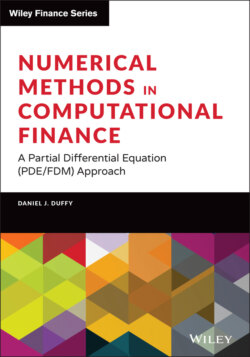Читать книгу Numerical Methods in Computational Finance - Daniel J. Duffy - Страница 42
2.4.1 Exponential Fitting
ОглавлениеWe now introduce a special class of schemes with desirable properties. These are schemes that are suitable for problems with rapidly increasing or decreasing solutions. In the literature these are called stiff or singular perturbation problems (see Duffy (1980)). We can motivate these schemes in the present context. Let us take the problem (2.1) when is constant and is zero. The solution is given by a special case of (2.2), namely:
If a is large then the derivatives of tend to increase; in fact, at , the derivatives are given by:
(2.23)
The physical interpretation of this fact is that a boundary layer exits near where is changing rapidly, and it has been shown that classical finite difference schemes fail to give acceptable answers when is large (typically values between 1000 and 10000). We get so-called spurious oscillations, and this problem is also encountered when solving one-factor and multifactor Black–Scholes equations using finite difference methods. We have resolved this problem using so-called exponentially fitted schemes. We motivate the scheme in the present context, and later chapters describe how to apply it to more complicated cases.
In order to motivate the fitted scheme, consider the case of constant and . We wish to produce a difference scheme in such a way that the discrete solution is equal to the exact solution at the mesh points for this constant-coefficient case. We introduce a so-called fitting factor in the new scheme:
The motivation for finding the fitting factor is to demand that the exact solution of (2.1) (which is known) has the same values as the discrete solution of (2.24) at the mesh points.
Plugging the exact solution (2.22) into (2.24) and doing some simple arithmetic, we get the following representation for the fitting factor :
(2.25)
Having found the fitting factor for the constant coefficient case, we generalise to a scheme for the case (2.1) as follows:
(2.26)
In practice we work with a number of special cases:
(2.27)
In the final case is the hyperbolic cotangent function.
In later chapters we shall apply the fitting scheme to the one-factor and multifactor Black–Scholes equations, and we shall show that we get good approximations to the option price and its delta in all regions of space where is the underlying asset and is time (up to maturity ). This is in contrast to the Crank–Nicolson scheme where the spurious oscillations are seen, especially when the underlying is near the strike price or when the payoff function is discontinuous.
